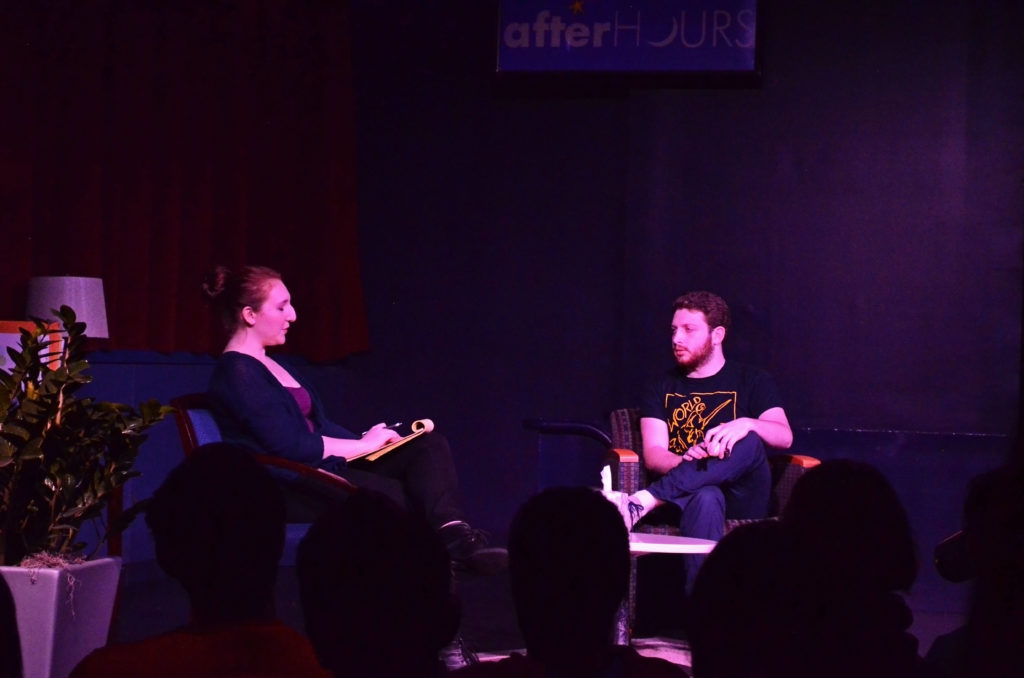By Sahan Weerakoon, deputy A&E editor
A teacher writes on an imaginary blackboard to her invisible students. She asks questions, but no one answers. At the end of the one-sided discussion, she is on the verge of tears.
Acting Out, a Northeastern University theater group focused on bringing social change through performance, presented “New York” to a packed afterHOURS crowd on Friday, Feb. 19. Directed by junior communications major Stephanie Eisemann, the play chronicles the story of witnesses to the 9/11 attacks in New York City.
The play’s vignette style had characters in almost every scene talking to a psychologist about their ongoing emotional trauma following 9/11.
“The vignette style allowed a nice change of pace,” Eisemann said. “You could have written a play about each character.”
The isolated scene structure allowed Eisemann to mentor her actors for just their scene, making each moment hyper-focused on each actor’s purpose.
The therapist was the only exception to this rule. Despite being in the majority of the play, she served as a liaison between the audience and the survivors.
“[The therapist] was definitely there to coax the other characters into speaking,” Katherine Hut, a freshman behavioral neuroscience major who played the therapist, said. “Her main role was to facilitate just the continuation of the play.”
The eclectic group of patients was highlighted by a fireman who spites himself for being the only survivor of his company; a news reporter who struggles to adapt to her career after 9/11; a human resources director who feels responsible for the death of an estranged college classmate; a detective who looks for physical remnants of the victims; and a babysitter, who blames himself for not caring more about his friend’s loss.
Freshman chemical engineering major Adam Lyons, who plays homicide detective Tony Del Girono, lauded the variety of characters in the play for helping him discover how a tragedy like this affects everyone.
“The vignette style glimpses helped let me know no matter who we are, we’re all affected by tragedy,” Lyons said.
Lyons’ character serves as an important reference point who not only feels obliged to carry the burden of a loved one lost but also believes he must carry the memories of all the victims.
Del Girono visits the therapist in search of closure, but his and the other patients’ futures are left in the air after they leave the room.
Eisemann notes that this was an intentional choice due to the style of the play, and most stories still hinted at varying degrees of closure.
“Simply them being there and discussing their problems already shows a step forward that is taken by each character before the lights go on in their scene,” Eisemann said.
After the play, Eisemann, president of Acting Out and senior marketing major Conor Gay and the cast led a talkback to discuss with the audience what it means to move on from tragedy. The talkback especially challenged audience members with the question: “Have our careers and lives been completely defined by this day?”
Gay notes that this question, along with “what do we do from here?” describes the struggle the survivors faced daily and why they’re in the therapist’s office in the first place. In her final exchange with Del Girono, who can’t bring himself to forget the survivors, the therapist tries to answer the first, citing tragedy as just another fact of life.
“You don’t have to know her last name,” Hut said. “You won’t forget her. You’re part of the same thing, remember? This amazing thing? We’re all part of it.”
Stephanie Eisemann is a staff writer for The Huntington News.
Photo courtesy Conor Gay, Acting Out









